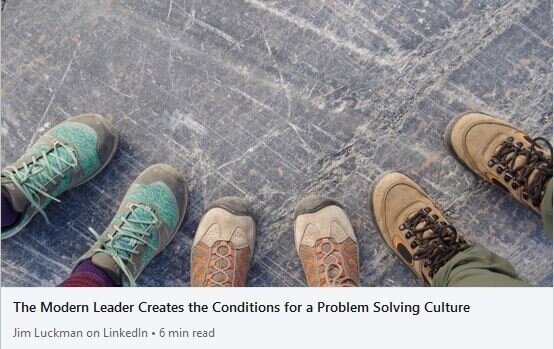How one CEO saved his 12,000-person company without a single layoff
https://marker.medium.com/companies-dont-need-to-lay-people-off-to-survive-4197a9e57f6c
Photo courtesy of Bob Chapman
https://marker.medium.com/companies-dont-need-to-lay-people-off-to-survive-4197a9e57f6c

Photo courtesy of Bob Chapman
What Zero Looks Like: Eliminating Hospital-Acquired Infections
IHI (Institute for Healthcare Improvement)
follow link to article below, some points from it:
1.7 million hospital patients ― 4.5 of every 100 admissions ― become infected each year, causing or contributing to the deaths of nearly 100,000 people.
Beginning in 2005 with its initial 100,000 Lives Campaign and now 5 Million Lives Campaign, and with the help of several scientific partners, the Institute for Healthcare Improvement has targeted for prevention and reduction 3 HAIs:
1) ventilator-associated pneumonia (VAP),
2) central line-related bloodstream infection (CLRBI), and
3) surgical site infection (SSI)
― which, according to the CDC, account for an estimated 50% of all HAI-related deaths.
Joe McCannon, manager of the 5 Million Lives Campaign, and an IHI vice president
Hospitals participating in the Campaign significantly reduced their monthly HAI rates, in some months all the way down to zero, and “a surprising number were getting down to zero and staying there.”
FOR CHANGE TO STICK, AN ORGANIZATION HAS TO REVAMP ITS CULTURE as well as its procedures.
not just zero infections but zero tolerance for non-compliance with proven prevention measures
When you’re talking about something that can cost people their lives and zero is possible, no other benchmark makes sense.
“We dug into the details and found that, officially, good processes were in place but they had broken down or, in some places, were being ignored.” Staff re-education and greater accountability were part of the remedy but the hospital also decided to post large charts in the corridor of the operating rooms, tracking monthly SSIs with big black dots. “That helped keep all staff and physicians aware of our need to improve,”
“We don’t blame anyone, we look for poorly designed processes and try to fix them”
After much work on “culture and transparency, we now have nurses admitting to short-cuts and violating policies ― and they tell us why.”
the rate of deep chest surgical site infections following CABGs got down to zero and with some exceptions, has remained at zero for multiple months at a time ― the longest was a 15-month stretch
hospital has been able to reduce its rate of ventilator-associated pneumonia ― an infection that enters the body via a mechanical breathing tube ― to zero, sustaining that level for as long as two years.
overall infection rate was reduced from 3.6 cases per 1,000 patient days before the intervention to 0.85 cases
it’s reasonable to expect that zero infections will become a widely-accepted goal for hospital performance.
"People want to do the right thing.

Healthcare practitioners share a set of tips hospitals can apply today to support their battle against the corona virus.
read here:

"And if we got production down to 8 weeks (from 12 weeks), what would happen?"
"We would control the market."
This is how lean is a competitive advantage driving sales growth.
“Lean is about being able to do things that our competitors can’t do. It’s about creating capabilities within our own company that our competitors can’t easily copy. ”
Emphasis on: companies apply lean with the wrong vision.
Too often, lean is seen as “cutting away” rather than “creating".
It’s misinterpreted as a cost-reduction tactic rather than a market building strategy.
Article link to: Is Agility More Important than Lean?
With the right vision, the two go hand-in-hand.
by Rick Bohan
What to expect as a Lean Manager?
- depends on the CEO's commitment
Operational Excellence: the CEO has delegated to one of their executives a program to generate savings or improvements.
Lean transformation: the CEO is working with a coach to spend more time where the revenue generating business is done and change how they are running the company.
understand which problem we’re trying to solve:
a program of productivity improvement workshops to deliver savings,
or a program of gemba walks to deliver ideas and voluntary engagement in trying new ways of satisfying customers.
Great article by Michael Balle here: https://www.lean.org/balle/DisplayObject.cfm?o=5173
The Modern Leader Creates the Conditions for a Problem Solving Culture
highlights from Jim Luckman’s article, link below
“Start by considering whether or not you are operating within an outdated model of leadership”
“you are likely operating inside the old paradigm, typical of most companies, that imposes blanket solutions on performance problems without first understanding your organization’s real, most urgent business problems.”
Recognizing the Old (and Totally Outdated) Philosophy of Leadership
“common leadership practices that consistently create poor outcomes.”
“Another outdated idea? Most leaders today still believe that maximizing profits is the purpose of the organization.”
“It addresses the focus on customers vs. profits.”
“What percentage of your daily activity is tied to maximizing profit (sales growth and cost savings) vs. improving value delivery to your customers?”
The problems are driven by a lowest-piece-price strategy that leads to LONG distances. *That's not JIT.
Excellent business write up for senior management coherency regarding the supply chain they have set up by Mark Graban here:

- Fundamentals of current design & engineering practices most companies are behind on – where is yours?
seminar presented by Allen Ward to Saab

“typically 3 years after the beginning of the transformation businesses will have the opportunity to dramatically outperform their non-lean industry peers.
management should learn to see the methodology as a #Strategy rather than a set of tools, and framing the transformation as the development of a system for continuous improvement and learning rather than the simple improvement of processes.”
another great piece by Jim Luckman here:
https://www.linkedin.com/pulse/modern-leader-creates-conditions-problem-solving-culture-jim-luckman

“they already have the person in place that should lead the transformation, the CEO.”
“The CEO must not only verbalize his commitment to the Lean Transformation, he must show it in his actions."
“If the CEO delegates away his responsibilities to a staff position within the company, the Lean transformation will stall and eventually fail. The CEO must be as committed to the process of the transformation as he is to the results.”
“a Lean transformation is all about people.”
“one must think about Lean as a growth strategy.”
“You may need to decide NOT to do business with a group of customers if employee and/or shareholder requirements are not met.”
Coaching is not about making ourselves feel good through sharing knowledge and wisdom; coaching is about helping others arrive at their own knowledge and wisdom.

They hired her to make the firm better, but the firm’s leadership wanted to believe they were already great.
Some management demonize people, accusing them of being the problem instead of solving the problem that is being raised.
It’s not comfortable to see your shortcomings; this discomfort causes leaders to deflect and defend, and when leaders do this, they limit whether their organization advances.
article here: https://hbr.org/2020/01/dont-demonize-employees-who-raise-problems

knows as Material & Information Flow Map
Do you have a current state maps posted that’s dusty, changing colour and so outdated the corners are starting to curl? send me a photo, & read David’s article
‘The map is a problem solving tool for identifying, prioritizing, and addressing problems in work flow that affect performance as measured, first and foremost in terms of effectiveness in delivering the work flow (timing, quantity, and quality) to the customer.’
‘Cost is a separate issue, and efficiency is a concern that comes only after delivery.’
“These plans are meant to focus on contributing the operation’s hoshin (or strategic) priorities for the year. “
Part of this pdf (which is full of great business content)
http://www.lean-transform.com/Customer-Content/www/CMS/files/Learning_Together_LTGMarch2020.pdf
Calgary - Edmonton could lead the way establishing a rail connection,
(despite being 80 years behind schedule to do such)

If Madrid and Barcelona can build a high-speed rail connection, why can’t Toronto and Montreal?
*Train service to Toronto does free up 5 hours of work time otherwise lost to staring through a windshield driving; this alone can be worth the price depending on the person
credit to Jason Premo
“A great example of how display of information visually can have a great impact on the customer experience. Paul Akers, the author of “2-second Lean” talks about “fix what bugs you” and we all have opportunities to do exactly that at work and home.”
like it or comment where he posted it on linkedin here: https://www.linkedin.com/posts/jasonpremo_leanthinking-leantransformation-leanmanufacturing-activity-6549633776622854144-A_Mu


- excerpt from an email I sent a hospital CEO, VP, CFO & a few colleagues after a Lean Government workshop to help them; hoping it also helps some others here interested in current healthcare practices
Designing new Hospitals from scratch using 3P; Saskatchewan, Dan Jones
https://www.lean.org/LeanPost/Posting.cfm?LeanPostId=111
Virginia Mason Health System, Seattle
https://www.virginiamasoninstitute.org/2017/08/lean-health-care
books:
https://www.virginiamasoninstitute.org/knowledge-base/books
Thedacare Health
Book:
On The Mend by CEO Doctor John Toussaint
- describes how ThedaCare doubled its revenue,
and how this organization became the lowest-price health care provider in Wisconsin.
One typical example: the mortality rate for coronary bypass surgery dropped from 4% a year (12 deaths) to almost zero (one death in 2009).
In addition, the time that the patients stayed in hospital fell (22%) from 6.3 to 4.9 days.
https://www.business-improvement.eu/lean/ThedaCare_On_The_Mend.php
Examples of results obtained at PHSA (Provincial Health Services Authority)
http://www.phsa.ca/documents/improveoct4.pdf
Cheers,
Ryan Cartier
great example from Fastcap
https://www.linkedin.com/posts/paulakers_8wastes-2secondlean-lean-ugcPost-6623991228822286336-k48R
“Several companies have Lean programs in place, but the uptake has too often proved superficial and focused solely on the use of tools (like 5S or visual management).
So far, most of industry has failed to understand the importance of changing managerial practices and leadership behaviors.”
https://planet-lean.com/lean-management-mining-industry

while driving to the airport in AZ I heard a podcast on how mining is adopting current business practices, drop me a line if interested
Tech firms look for solutions as data centres use huge amounts of power to fuel streaming and social media

this will continue to drive demand for data center liquid cooling solutions.
We've already experienced this in Europe: